Previous page: Torghundi and the railway from Turkmenistan
The most important railway in Afghanistan is the line to the border town of Hairatan from Termez in Uzbekistan. The 1520 mm gauge line crosses the River Amu Darya on the road and rail Friendship Bridge, which is one of the most significant freight routes into the country.
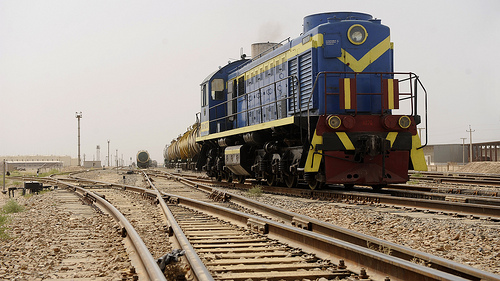
There are rail, road and barge freight facilities at the Hairatan border crossing. (Photo: Asian Development Bank).
Trains bring goods to Afghanistan including oil and fuel, wheat and flour, fertilizer, construction materials, agricultural and off-highway equipment and consumer goods.1 The bridge also forms part of the Northern Distribution Network taking military supplies to international forces in Afghanistan.
Until the opening the 75 km railway to Mazar-i-Sharif in 2011-12, all goods had to be transshipped to road at Hairatan, where freight handling and Afghan border facilities had been developed around the end of the Friendship Bridge. The railway extension means freight can now be further inside Afghanistan.
The Friendship Bridge
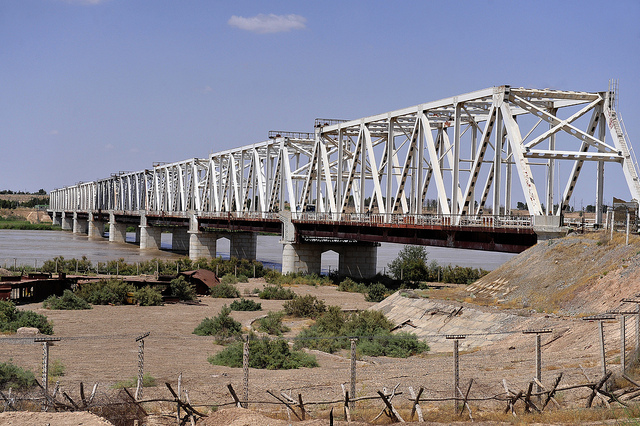
The Friendship Bridge crosses the Amu Darya which forms the border between Uzbekistan and Afghanistan (Photo: Staff Sgt. Bradley Lail/US Air Force)
The railway to Afghanistan link starts a few kilometres east2 of the city of Termez in Uzbekistan, which has rail connections eastwards to Dushanbe in Tajikistan and westwards via Kerichi to Bukhara and Samarkand. Termez has gained further lines since Uzbek independence.
The main feature of the line to Afghanistan is the bridge across the River Amu-Darya (Oxus) which forms the border between the countries.
There had been river traffic between Termez and Afghanistan for many years, but there was no fixed link until the USSR built a pontoon bridge to support its intervention in Afghanistan in 1979. This pontoon bridge – possibly a short distance from the site of the later bridge – was soon replaced with a more permanent structure, which was named the "Friendship Bridge"3.
The Friendship Bridge comprises a series of steel truss spans, giving a total length of around 816 m and width of 15 m. The single railway track runs down the middle of the road, and the bridge also carries an oil pipeline. Construction cost 34m roubles and was underway by September 1980.4
An agreement for use of the bridge was reached between the Afghan and Soviet authorities in May 1982,5 and an official opening ceremony was held on 12 May 1982,6 following the arrival of officials and a tree-planting the previous day.7 Attendees included the Secretary General of the Central Committee of the People’s Democratic Party of Afghanistan and Chairman of the Revolutionary Council of the Democratic Republic of Afghanistan Babrak Karmal and First Secretary of the Central Committee of the Communist Party of Uzbek Soviet Socialist Republic Sharaf Rashidov.
To establish a station for unloading goods, they built a town named Hayratan, a dismal place with a railway yard and some houses belonging to the railway workers and army personnel.
In Babar’s footsteps, MHA Beg, Dawn, 14 May 2006
The length of the railway has been quoted as 15 km, but it is unclear exactly what this figure refers to: the distance from the Termez, from the junction in Uzbekistan, or the length of the various sidings in Afghanistan.
War and the Friendship Bridge
The Friendship Bridge strengthened the strategic transport capabilities of the USSR by establishing a railhead on the south side of the Amu-Darya, with transshipment and storage facilities.
As a result, railway lines parallel to the river on the Soviet side of the border were subjected to cross-border sabotage and military attacks by anti-Soviet Mujahideen forces, who were able to launch rockets from within Afghanistan or mount cross-border raids.
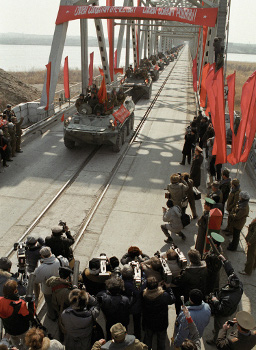
Withdrawal of Soviet troops from Afghanistan, 1 October 1989
(Photo: RIA Novosti archive, image #58833/A.Solomonov/CC-BY-SA 3.0)
In early 1985 Pakistan’s Inter-Service Intelligence began to formulate plans for the Mujahideen to destroy the bridge.8
The USA’s CIA provided advice on the types of explosives needed, and where they should be placed to demolish two or three spans. The underwater demolition operation was planned for the summer, to obtain maximum benefit from the current flows in the Amu-Darya. A team of troops was to practice the assault on an Afghan dam. The CIA would not supply good reconnaissance photographs of the bridge or any information about Soviet territory, and so local Mujahideen commanders provided details of the sentries and military post on the Afghan end of the bridge, where an armoured personnel carrier was permanently on duty.
However, later in the year the President of Pakistan vetoed the proposed attack, fearing it might lead to reprisal attacks on vital bridges in Pakistan.
Soviet railway plans
The USSR had plans to extend the railway onwards to Kabul. The first phase would have run 250 km to Pul-i-Khumri, 150 km north of the capital,9 and the location of a major military supply depot.
From the Friendship Bridge the railway was to have run southwest to Kholm, east towards Kunduz and Khanabad, then would climb south through Ab Kul and Bahlan, and reach the Surkhab river valley and Pul-i-Khumri in the foothills of the Hindu Kush mountains.10
A second stage of the plan would have taken the line to Bagram air base, then on to Kabul. The complete line to Kabul was expected to cost 3.1bn roubles.
These projects were not carried out.
Closing the border
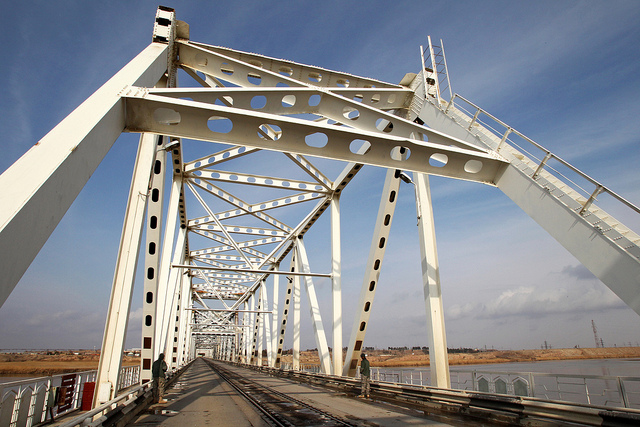
The Friendship Bridge (Photo: S Wilke/Bundeswehr 2011-01-13)
The last Soviet troops withdrew from Afghanistan across the Friendship Bridge in February 1989,11 and the railway fell out of use at some point.
Following the Taliban’s rise to power in Afghanistan, Uzbekistan closed the bridge on 24 May 1997, fearing Afghanistan’s problems might spread north across the border and Islamist militants could threaten the Uzbek government. The border is protected with mines and electric fences.
Re-opening the border
Uzbek Railways TEM2 loco at Hairatan (Photo: David Brice)
The Friendship Bridge is the only fixed link between Afghanistan and Uzbekistan, and traffic had to cross the river by barge while the bridge was closed. Following the US-led intervention in Afghanistan, from October 2001 there was international pressure on Uzbekistan to reopen the bridge to enable aid to be delivered to northern Afghanistan in larger volumes than could be handled by river.
A trim two-lane span with shallow train tracks running down the center, the bridge was splendid, solid, clean – until we came to its indisputably Afghan side. Suddenly graffiti streaked along the girders, all of it scrawled in indecipherable Arabic-alphabet Persian.
War Zones for Idiots, Tom Bissell, World Hum, 21 October 2002
US Secretary of State Colin Powell met Uzbek President Islam Karimov to discuss the matter, and following inspections to ensure the bridge was safe it was reopened on 9 December 2001.12 13
The first train across the bridge carried 1000 tonnes of grain, flour and non-food items donated by the Uzbek government in 14 or 15 bogie vans hauled by Uzbek national railway UTY’s locomotive 3199, a Class TEM1 Co-Co. This class was developed from 1958 based on Alco designs supplied to the USSR by the USA in 1944-45. A banner on the locomotive read “From the Uzbek people to the Afghan people”. The train was met by warlord Abdul Rashid Dostum, who inspected the load.14 United Nations relief agencies launched a programme to ship as much food into Afghanistan as possible before the onset of winter.
In December 2002, the government of Uzbekistan adopted a resolution on opening the bridge “to ensure effective provision of aid rendered by the world community to Afghanistan”.15
Extension
In 2010-12 the railway was extended 75 km from Hairatan to Mazar-i-Sharif, Afghanistan’s first major main line railway other than the two cross-border spurs from the former USSR.
Place names
The location of the freight terminal is written in numerous ways in English. The trend seems to be away from y and towards i. Here are some versions I have seen:
|
فارسی Hairatan Hairaton Hayratan Hayraton |
Heiratan Heratan Heraton Khairatan Khairaton хайратон |
The cross-border bridge is usually called the Friendship Bridge in English, although Freedom Bridge has been used in some (mostly US?) sources.
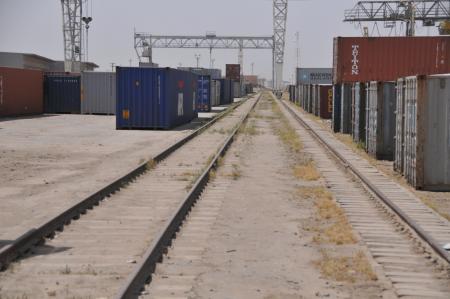
Railway siding and containers at Hayratan (Photo: Peter Mayes/DVIDS, 2011-04-26)
News
News and updates about Hairatan.
Next page: War and reconstruction
References
- Proposed Asian Development Fund Grant Islamic Republic of Afghanistan: Hairatan to Mazar-e-Sharif Railway Project, Asian Development Bank, September 2009 ↩
- Some older published sources say west, however modern maps and aerial photographs confirm that the bridge is to the east of the city ↩
- There are numerous other Friendship Bridges around the world ↩
- Russians switch to commando-type raids in Afghanistan, Karan Thapar, The Times, 19 September 1980, p1 and p6 (Issue 60728; col C) ↩
- USSR-Afghan link, Modern Railways, August 1982 p342, quoted at University of York ↩
- Photo at Торжественное открытие железнодорожного и автомобильного моста,соединившего города Термез в Узбекистане и Хайратон в Афганистане; среди присутствующих у ленты: Генеральный секретарь ЦК НДПА Бабрак Кармаль (1-й справа), Председатель СМ ДРА Каштманд Султан-Али (2-й справа), 1-ый секретарь ЦК КП Узбекистана Ш.Р.Рашидов (5-й слева). ↩
- Photo at Аннотация: Руководители Узбекистана и члены правительственной делегации ДРА во время посещения парка “Дружбы” в Термезе; Генеральный секретарь ЦК НДПА Бабрак Кармаль (справа) сажает эльдарскую сосну в память о завершении строительства автомобильно-железнодорожного моста через Амударью, среди присутствующих: 1-ый секретарь ЦК КП УзССР Ш.Р.Рашидов (в центре). ↩
- Afghanistan – The Bear Trap – Defeat of a Superpower, Brigadier Mohammad Yousaf, (published 1992, 2001 edition referred to) ↩
- Kabul to be linked to Soviet Railways, Railway Gazette International, April 1983, p236, accessible at University of York ↩
- Afghanistan – a Country Study, Area Handbook Series, 5th edition, 1986 ↩
- Last Soviet Soldiers Leave Afghanistan, Bill Keller, New York Times, 16 February 1989 ↩
- Aid flows as key Afghan border bridge re-opens, Robert Pelton, CNN, 9 December 2001 ↩
- Breakthrough in Afghan aid effort, BBC News, 2001-12-09 ↩
- Afghanistan: Aid agencies welcome opening of bridge, IRIN, 10 December 2001 ↩
- On participation of the Republic of Uzbekistan in post-war reconstruction of Afghanistan, press release, Ministry of Foreign Affairs, Uzbekistan, 27 October 2008 ↩
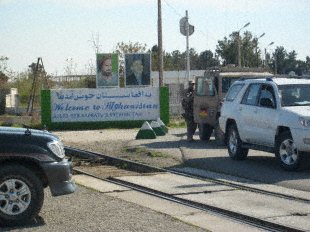
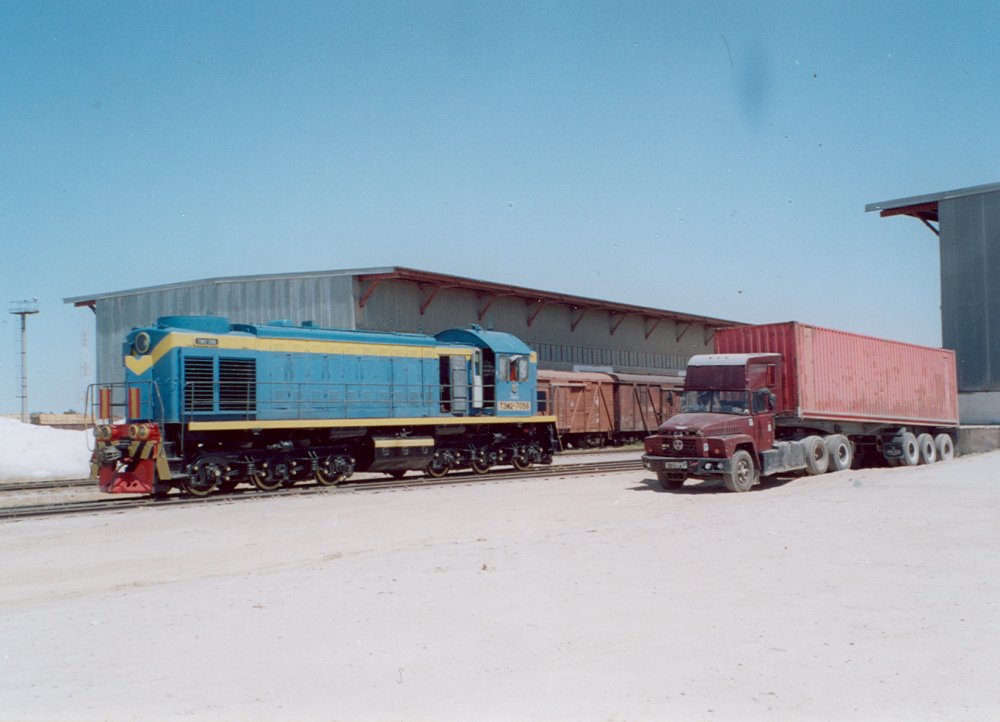
Actually, the name of this bridge is HIRATAN. We were there welcoming our troops back home.
When I served there as an advisor the soldiers in Afghanistan referred to the bridge as the Victory Bridge which really made the people coming over from Uzbeckistan angry. Oh well, they did not seem friendly to begin with.
I am from hayratan we always welcomed uzbek people but they are angry with us
actually I don’t know the reason
i crossed friendship bridge while traveling from termez to mazar shareef in summer vacation in july 1989 it was wonderfull trip .
The friendship bridge is the one of example of marvellous engineering of Soviet Union.